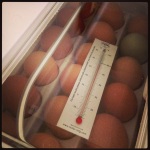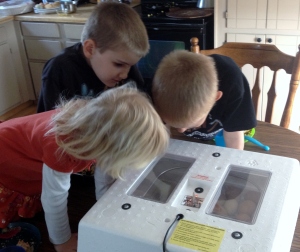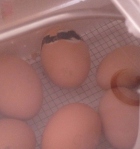I’ve had a few flocks of chickens over the past decade. It started when I arrived home one night to find an eerie, red glow inside my kitchen. Turns out my adorable in-laws had decided to surprise me baby chicks. At the time, I knew absolutely nothing about raising chickens. And I mean nothing.
Fast forward ten years, and I’m teaching my kids about chickens. That doesn’t mean I’m not still learning about the birds myself. Just today, I heard one of our Rhode Island Reds growling a little like a bull when another hen got too near her. I’ve never heard that sound in my life. Turns out she’s decided to hatch some eggs. I’m not about to argue with her.

Speaking of hatching eggs, there has been plenty of that going on. Two of our Silkie hens went broody in the past months. Fluffy Mama hatched four sweet little chicks. Marshmallow’s still sitting. She’s been having some trouble, primarily due to another hen that thinks Marshmallow should hatch eggs for her. Lazy hen. At any rate, all the excitement of new baby chicks inspired us to break out the incubator that I’ve been meaning to put to use and try our hand at hatching eggs.
Of course, it started with collecting eggs from our chickens. Now that we have an ample supply of eggs, it didn’t take more than a few days to collect enough to fill our incubator. As we  learned, it’s important to store your eggs-in-waiting large side up. That’s where the air cell is located. The eggs also need to be turned 3 times a day, which is something we learned later in the process and probably contributed to the loss of several potential chicks. My biggest concern before incubation was that we have one rooster for about 21 hens. He’s an ambitious character, but even so, there’s only so much one guy can handle. (For more consistent fertilization, you want about 10 hens per rooster.) Still, we decided to try anyway.
learned, it’s important to store your eggs-in-waiting large side up. That’s where the air cell is located. The eggs also need to be turned 3 times a day, which is something we learned later in the process and probably contributed to the loss of several potential chicks. My biggest concern before incubation was that we have one rooster for about 21 hens. He’s an ambitious character, but even so, there’s only so much one guy can handle. (For more consistent fertilization, you want about 10 hens per rooster.) Still, we decided to try anyway.
I bought an automatic egg turner for our still-air incubator, which I highly recommend. I don’t know about you, but I just don’t have time to turn 41 eggs three times a day. Aside from turning the  eggs, the temperature must be monitored so that it stays at 99.5 degrees Fahrenheit, for chicken eggs that is. Temperatures above 103 degrees Fahrenheit can kill the embryos, while a significant drop in temperature can do the same. Of course, it should be noted that many incubators cycle off for 15 minutes or so a day to simulate when a mother hen would normally get up off her nest to eat and drink. Once you have the temperature in that sweet spot, humidity levels must be maintained. In our model, this is accomplished through keeping water in the base, below the egg turner. (Interestingly enough, duck eggs require much more humidity which can be achieved through additional daily misting.) The only thing missing now is the eggs! Again, it’s important that the air cell (larger end) is at the top.
eggs, the temperature must be monitored so that it stays at 99.5 degrees Fahrenheit, for chicken eggs that is. Temperatures above 103 degrees Fahrenheit can kill the embryos, while a significant drop in temperature can do the same. Of course, it should be noted that many incubators cycle off for 15 minutes or so a day to simulate when a mother hen would normally get up off her nest to eat and drink. Once you have the temperature in that sweet spot, humidity levels must be maintained. In our model, this is accomplished through keeping water in the base, below the egg turner. (Interestingly enough, duck eggs require much more humidity which can be achieved through additional daily misting.) The only thing missing now is the eggs! Again, it’s important that the air cell (larger end) is at the top.
Chicken eggs will hatch in 21 days under optimal conditions. If you have an automatic egg turner, your only job for first 18 days is to check on the temperature and humidity inside the incubator. The water will certainly need to be refilled at several points. On the 18th day, the egg turner has to be removed and the eggs are placed on a the mesh bottom that comes with the incubator. No more turning, as the chicks are getting in position for hatching. Humidity is also very important at this point as it helps to soften the shell, making the chicks job a lot easier. Aside from that, the most difficult task is waiting. And waiting.
Our first chick hatched in the middle of the night, at about 4:30 AM on day 23. Curious fact about hatching chicks is that you hear them long before you see them, sometimes before there is any significant cracking in the

egg. The first hole the chick makes, called pipping, allows air to reach the chick. Over the course of anywhere from one to twenty-four hours, the chick will use its egg tooth to continue to break around the circumference of the egg. At that point, once it has mustered up as much energy as possible, it kicks free of the egg. As this was our first time hatching chicks, we had a few moments where we got concerned and were tempted to intervene. But after much Googling, we decided it would be best to leave things to nature as it’s very important for the chick to absorb the remainder of the

yolk through its umbilical cord. (Chicks have umbilical cords! Also something I didn’t know!) Following recommendations, we left the chicks in the incubator for several hours to dry off and acclimate before moving it to our homemade brooder. We read that the gender of the chicks can be predicted with 90% accuracy based on the shape of the egg – rounded eggs are hens, while pointed eggs are roosters! I really can’t verify whether or not this is true, but I look forward to finding out.
Our temporary brooder is just a large Rubbermaid container, filled with pine shavings and topped with non-slip shelf liner. The shelf liner helps prevent spraddle leg, a condition that occurs in the leg development of a chick if they are put on difficult surfaces or overcrowded. From my experience, it’s not easy to treat once it’s happened and a roll of liner from the dollar store is well worth the investment. The other dollar store upgrade I made to their brooder is filling the bottom of the waterer with glass rocks to prevent the chicks from drowning. Those $2 goes a long way, I assure you. As far as warmth goes, you could use an incubator thermometer to monitor the heat of the brooder lamp. But as they are usually exposed and chickens will peck at virtually anything, I prefer to use a refrigerator thermometer that I picked up at Acemart. Not only is it half the price of incubator thermometers, but it’s enclosed in a sturdy glass tube that I have yet to see a chicken (or duck) break.

The kids have been thrilled to listen for and watch the various stages of hatching. We’re up to six chicks so far, which isn’t a lot considering 41 eggs went in. But as we candled the eggs on day 18, we’re not at all surprised by the outcome. Many of the eggs simply weren’t fertile. All in all, the kids agree that this is the best science experiment we’ve ever done and we plan on starting it all again in a few days!
